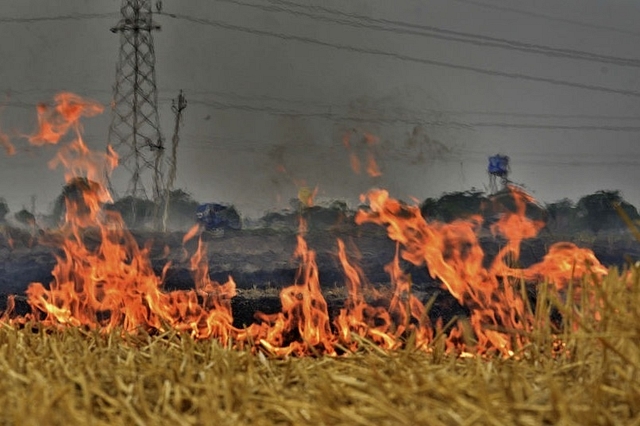
Why Haryana Fares Better Than Punjab In Managing Paddy Stubble
Haryana is able to manage more than 80 per cent of its crop residue while Punjab manages only 50 per cent, burning the rest.
After a brief hiatus, air quality in Delhi has again become terrible. And the reason is still the ongoing stubble-burning spree in neighbouring states.
The residents of the National Capital Region got some relief for a week thanks to favourable wind conditions which blew away the pollution but the winds seem to have turned stationary once again.
Share of stubble burning in Delhi’s pollution reached 46 per cent on 1 November, the highest in the season. Later it dropped to a mere three per cent on 6 November, thanks to winds. On 12 November, it reached 25 per cent and has only become worse since then.
Both Haryana and Punjab have received a lot of flak for not doing enough to stop farmers from burning their paddy stubble and choking the national capital with hazardous air.
This ire is genuine but slightly misplaced for the situation of stubble burning in Punjab is much worse than it is in Haryana. Take a look at the NASA fire map below that shows data for the last month.
Except districts such as Kaithal, Karnal and Fatehabad close to the Punjab border (they account for almost half of Haryana’s fires), stubble burning seems quite under control in the state.
As per the Haryana Space Applications Centre, until 12 November, the state had detected 6099 active fire locations (since 25 September). This figure is still much lower than last year’s figure of around 10,000 fires.
On the other hand, the figure had crossed 48,000 in Punjab on 10 November (since 23 September). By now, it would’ve already surpassed last year’s number of 49,000 cases. With almost 2,000 new cases being added, the figure is likely to end up much higher than last time.
In 2018, Punjab accounted for 88.15 per cent of the paddy straw burnt in these two states while Punjab’s share in the total paddy straw generated by these two is only 70 per cent.
Haryana is able to manage more than 80 per cent of its crop residue while Punjab manages only 50 per cent, burning the rest.
Haryana is definitely doing something right.
For one, it is more strict on farmers than Punjab. In 2017, the administration filed 236 FIRs on farmers burning paddy crop residue in contravention of the government’s regulations.
During the wheat harvest season, the FIRs filed stood at 882. Last year, 167 FIRs were filed and 95were filed this year post wheat harvest. Punjab, on the other hand, filed only 202 FIRs (till 1 November) when incidents of stubble burning stood at 20,000 (more than double of what Haryana’s was last year).
Another reason for Haryana faring better is its ability to target the farmers who are prone to burning their crop stubble. Most of the incidents occur in the northern belt, neighbouring Punjab, and only a select few districts make up for the overwhelming majority of fire-burning incidents.
Given this, the Haryana government is able to target those places for monitoring and providing machinery like happy seeders that is used to plough the stubble back into the field along with the seeds.
S Narayanan of the Haryana Population Control Board told Down To Earth that, “The government identified villages where farm fires were rampant last year and just as the kharif season began in June, we started distributing machines that can eliminate crop residue burning.
“We did quite well on the technological front and supplied machines like Super SMS, Rotavator, Happy Seeder and Zero Till Seed Drill.”
This year, Haryana has achieved its target of supplying machines for straw management to its Custom Hiring Centres but Punjab is stuck at achieving only 30 per cent of its target.
As far as supplying machines to individual farmers is concerned, both states fare poorly (only ~33 per cent target has been achieved).
Farmers in central Haryana and those districts that fall in the National Capital Region (NCR) have almost completely stopped burning stubble.
This is because they collect the stubble at the village-level and sell it to the dairy industry for use in their cattle feed and get paid handsomely, sometimes as high as half of the amount they spend on harvesting.
Acting on the Supreme Court's orders, the Haryana government has also announced an incentive of Rs 100 per quintal to the small and marginal farmers who have not burned stubble.
Additionally, Chief Minister Manohar Lal Khattar said that his government will bear a sum of Rs 1,000 per acre as operational cost for management of crop residue by the small and marginal farmers of non-basmati paddy,
What these steps show is that the Haryana government has been more pro-active in dealing with the stubble burning issue even if it contributes much less to Delhi’s air pollution.
Punjab has a much bigger problem at hand and hence will need more drastic measures on its part and they seem to be missing.
CM Captain Amarinder Singh will have to crack the whip as well as give some carrots to the farmers to move away from paddy stubble burning or supply them with machines for stubble management.
He mustn’t dither in his duty for his inaction puts the health of millions of people at risk every year.